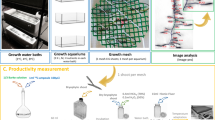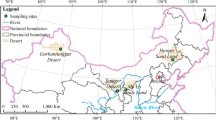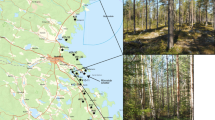Abstract
Terrestrial mosses are used as biomonitors to assess atmospheric pollution. The aim of this study was to evaluate the effects of chemical contaminants on the physiological responses of mosses. For this purpose, we transplanted clean moss samples to five sampling sites at different distances from a steelworks factory, for different lengths of time (four periods of 1 month, two periods of 2 months and one period of 4 months). At each sampling site, we collected bulk deposition samples, and we also measured the concentrations of Al, As, Cd, Cr, Cu, Fe, Hg, Ni, Pb, V and Zn in the moss tissues and determined the chlorophyll content (CHL) index, Fv/Fm ratio and moss growth rate, with the following aims: (a) to determine the relationships between the concentrations of elements in bulk deposition and moss samples, physiological traits and growth of the mosses; and (b) to determine whether such relationships are affected by the duration of exposure and level of contamination. Although we did not identify any such relationships, the CHL index and growth rate were both lowest at high concentrations of metals and metalloids in the moss tissues, which suggest the existence of a threshold type of response for both variables.



Similar content being viewed by others
References
Aboal, J. R., Couto, J. A., Fernández, J. A., & Carballeira, A. (2008). Physiological responses to atmospheric fluorine pollution in transplants of Pseudoscleropodium purum. Environmental Pollution, 153, 602–609.
Aboal, J. R., Fernández, J. A., Boquete, T., & Carballeira, A. (2010). Is it possible to estimate atmospheric deposition of heavy metals by analysis of terrestrial mosses? Science of the Total Environment, 408, 6291–6297.
Ares, A., Aboal, J. R., Carballeira, A., Giordano, S., Adamo, P., & Fernández, J. A. (2012). Moss bag biomonitoring: a methodological review. Science of the Total Environment, 432, 143–158.
Berg, T., & Steinnes, E. (1997). Use of mosses (Hylocomium splendens and Pleurozium schreberi) as biomonitors of heavy metal deposition: from relative to absolute deposition values. Environmental Pollution, 98(1), 61–71.
Berg, T., Royset, O., & Steinnes, E. (1995). Moss (Hylocomium splendens) used as biomonitor of atmospheric trace element deposition: estimation of uptake efficiencies. Atmospheric Environment, 29, 353–360.
Bignal, K. L., Ashmore, M. R., & Headley, A. D. (2008). Effects of air pollution from road transport on growth and physiology of six transplanted bryophyte species. Environmetal Pollution, 156, 332–340.
Bolhàr-Nordenkampf, H. R., Long, S. P., Baker, N. R., Öquist, G., Scheiber, U., & Lechner, E. G. (1989). Chlorophyll fluorescence as a probe of the photosynthetic competence of leaves in the field: a review of current instrumentation. Functional Ecology, 3, 497–514.
Branquinho, C., Brown, D. H., & Catarino, F. (1997). The cellular location of Cu in lichens and its effects on membrane integrity and chlorophyll fluorescence. Environmental and Experimental Botany, 38, 165–179.
Brown, D. H. (1995). Sequential elution procedures for establishing the cellular distribution patterns of metals in cryptogamic plants. In M. Munawar, O. Hänninen, S. Roy, N. Munawar, L. Kärenlampi, & D. Brown (Eds.), Bioindicators of environmental health (pp. 203–209). Amsterdam: SPB Academic.
Brown, D. H., & Sidhu, M. (1992). Heavy metals uptake, cellular location and inhibition of moss growth. Cryptogamic Botany, 3, 82–85.
Butler, W., & Kitajima, M. (1975). Fluorescence quenching in photosystem II of chloroplasts. Biochimica et Biophysica Acta, 376, 116–125.
Choudhury, S., & Panda, S. K. (2005). Toxic effects, oxidative stress and ultrastructural changes in moss Taxithelium nepalense (Schwaegr) Broth Under chromium and lead phytotoxicity. Water, Air, & Soil Pollution, 167, 73–90.
Fernández, J. A., Aboal, J. R., Real, C., & Carballeira, A. (2007). A new moss biomonitoring method for detecting sources of small scale pollution. Atmospheric Environment, 41, 2098–2110.
Lichtenthaler, H. K., Gitelson, A., & Lang, M. (1996). Non-destructive determination of chlorophyll content of leaves of a green and an Aurea mutant of tobacco by reflectance measurements. Journal of Plant Physiology, 148, 483–493.
Onianwa, P. C. (2001). Monitoring atmospheric metal pollution: a review of the use of mosses as indicators. Environmental Monitoring and Assessment, 71, 13–50.
Perez-Llamazares, A., Fernández, J. A., Carballeira, A., & Aboal, J. R. (2011). The sequential elution technique applied to cryptogams: a literature review. Journal of Briology, 33(4), 267–278.
Roiloa, S. R., & Retuerto, R. (2005). Presence of developing ramets of Fragaria vesca increase photochemical efficiency in parent ramets. International Journal of Plant Sciences, 166, 795–803.
Ross, H. B. (1990). On the use of mosses (Hylocomium splendens and Pleurozium schreberi) for estimating atmospheric trace metal deposition. Water, Air, & Soil Pollution, 50, 63–76.
Schreiber, U., Bilger, W., Hormann, H., & Neubauer, C. (1998). Chlorophyll fluorescence as a diagnostic tool: basics and some aspects of practical relevance. In A. S. Raghavendra (Ed.), Photosynthesis. A comprehensive treatise (pp. 320–336). Cambridge: Cambridge University Press.
Shakya, K., Chettri, M. K., & Sawidis, T. (2008). Impact of heavy metals (copper, zinc and lead) on the chlorophyll content of some mosses. Archives of Environmental Contamination and Toxicology, 54, 412–421.
Sun, S. Q., He, M., Cao, T., Zhang, Y. C., & Han, W. (2009). Response mechanism of antioxidants in bryophyte (Hypnum plumaeforme) under the stress of single or combined Pb and/or Ni. Environmental Monitoring and Assessment, 149, 291–302.
Takács, Z., Otvos, E., Lichtenthaler, H. K., & Tuba, Z. (1997). Chlorophyll fluorescence and CO2 exchange of the heavy metal-treated moss, Tortula ruralis under elevated CO2 concentration. Physiology and Molecular Biology of Plants, 10(2), 291–296.
Tremper, A. H., Agneta, M., Burton, S., & Higgs, D. E. B. (2004). Field and laboratory exposures of two moss species to low level metal pollution. Journal of Atmospheric Chemistry, 49, 111–120.
Tuba, Z., Csintalan, Z., Badacsonyi, A., & Proctor, M. C. F. (1997). Chlorophyll fluorescence as an exploratory tool for ecophysiological studies on mosses and other small poikilohydric plants. Journal of Bryology, 19, 401–407.
Tuba, Z., Saxena, D. K., Srivastava, K., Singh, S., Czobel, S., & Kalaji, H. M. (2010). Chlorophyll a fluorescence measurements for validating the tolerant bryophytes for heavy metal (Pb) biomapping. Current Science India, 98(11), 1505–1508.
Wagner, G. (1994). ESB in the Federal Republic of Germany. In: An instrument for long-term environmental monitoring, assessment and research (pp 57–462). Ecoforma 94, 5 Bayern
Wood, C. W., Reeves, D. W., & Himelrick, D. G. (1993). Relationships between chlorophyll meter readings and leaf chlorophyll concentration, N status, and crop yield: a review. Proceeding of the Agronomy Society New Zealand, 23, 1–9.
Zar, J. H. (1984). Biostatistical analysis. London: Prentice-Hall.
Acknowledgments
This study was partly funded by FEDER funds and by the Spanish Ministry of Science and Innovation (CTM2011-30305). S.R.R. was financed by a grant from the Portuguese Foundation for Science and Technology (FCT) (reference SFRH/BPD/79599/2011) co-funded by the European Social Fund of the European Union.
Author information
Authors and Affiliations
Corresponding author
Electronic supplementary material
Below is the link to the electronic supplementary material.
Rights and permissions
About this article
Cite this article
Varela, Z., Roiloa, S.R., Fernández, J.A. et al. Physiological and Growth Responses of Transplants of the Moss Pseudoscleropodium purum to Atmospheric Pollutants. Water Air Soil Pollut 224, 1753 (2013). https://doi.org/10.1007/s11270-013-1753-4
Received:
Accepted:
Published:
DOI: https://doi.org/10.1007/s11270-013-1753-4




